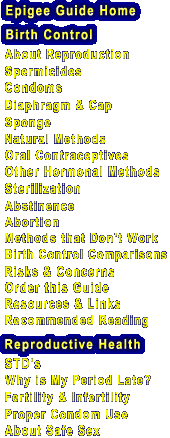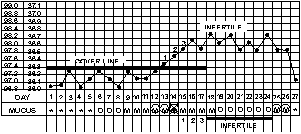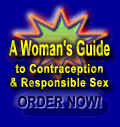






| ||||
Fertility awareness, or natural family planning, has been used successfully since the 1930's to predict a woman's fertile days. These methods are based on the fact that fertilization is most likely to occur around the time of ovulation. Intercourse is avoided during those times when a woman is fertile, thus preventing conception. Fertility awareness methods are the only methods of birth control which require the cooperation of both partners. Advantages of these methods are that they are very inexpensive, do not require the use of artificial devices or drugs, and have no harmful side-effects. In addition, many people prefer a natural, mutual method of preventing pregnancy. Even if fertility awareness isn't used as contraception, every woman can benefit from understanding the workings of her body.
|
Many doctors are reluctant to recommend fertility awareness methods because of the high failure rate of the rhythm method, the first natural method to come into widespread use. However, newer natural methods listed in this section are as effective as artificial contraceptives. Additionally, users of these methods tend to be very loyal, continuing to practice NFP longer than users of any other non-surgical, non-prescription method, which indicates high satisfaction among couples. To use fertility awareness as a form of birth control it is strongly recommended that you first confer with a trained counselor. Couples who use this method improperly are more likely to get pregnant than those who misuse artificial methods. |
A Woman's Monthly Cycle
 Above is a pictorial representation of a 32 day menstrual cycle. For this woman, ovulation takes place on day "17." |
Sympto-Thermal Method
Average Failure Rate:
15%
This method requires that a woman take her temperature every morning before she gets out of bed and record the reading. Depending on where she is in her menstrual cycle, there will be slight variations in her temperature. These variations are most easily measured with a special thermometer that has a range of only a few degrees, known as a basal thermometer. Before ovulation, the temperature is likely to be between 97.2 and 97.4 degrees F. After ovulation, it will rise by at least 0.5 degrees and is often above 98 degrees F. When the temperature stays elevated for at least three days, a woman may assume she has already ovulated. Intercourse for the rest of the cycle will not result in pregnancy. To determine the infertile time before ovulation, a woman needs to look at her pattern of previous cycles. Her last "safe" day is one week before the earliest recorded day of temperature rise, or 5 days after the first day of her period.
 By recording other cyclic symptoms,
in addition to basal temperatures, the infertile time before ovulation
can be more accurately predicted (see Ovulation Method,
below). Cervical mucus, mid-cycle cramping,
breast sensitivity, and mood swings are all symptoms which give
insight into the progression of a woman's cycle. With careful
monitoring, it is not difficult to predict your fertile period,
when intercourse is to be avoided. An NFP chart
for recording these changes is available to view or print out.
By recording other cyclic symptoms,
in addition to basal temperatures, the infertile time before ovulation
can be more accurately predicted (see Ovulation Method,
below). Cervical mucus, mid-cycle cramping,
breast sensitivity, and mood swings are all symptoms which give
insight into the progression of a woman's cycle. With careful
monitoring, it is not difficult to predict your fertile period,
when intercourse is to be avoided. An NFP chart
for recording these changes is available to view or print out.
Intercourse during the time before ovulation is less safe than the time after ovulation because sperm have been known to live up to six days. For this reason, some couples choose to have sex only after the fertile period. This practice, known as the post-ovulatory temperature method, is the most effective of all methods of true contraception, with a failure rate of only 1% among perfect users. However, it is not recommended because it requires a very long period of abstinence.
|
RECOMMENDED STUFF
|

- At this site:
- NFP Charting View or print out a full-sized chart for personal use
- The following links are provided as an informational resource or counterpoint and are not necessarily endorsed by the author:
- Fertility Awareness and NFP Service
- A Primer on Natural Family Planning includes a collection of short articles, FAQs, and links about NFP, infertility, breastfeeding, resources, NFP organizations, chastity, etc.
- CCL's Natural Family Planning Classes & Resources
- Nature's Method of Birth Control - The Ovulation Method
- ProFam NFP Software
- Family of the Americas Great information on NFP and risks of artifical contraception
- Pregnancy Surprises: Using a calendar to determine fertility could backfire: Healthyway article about natural methods
Ovulation Method
Average Failure Rate: 20%
The ovulation method, or mucus method, requires that a woman be aware of what is taking place in her body. It is based on the observation that, in the absence of mucus, no egg is present, and sperm cannot survive long enough to fertilize an egg which may later be released. During a typical monthly cycle, a woman first has a few days of menstrual bleeding, followed by a few "dry days" when the vagina seems quite dry. Then, closer to ovulation she starts to have more wetness or mucus. As ovulation approaches, the mucus becomes clear and slippery and stretches without breaking, like a raw egg white. The last day of peak wetness is right before ovulation, then come days of less mucus. If any is noticed it will be cloudy. Any time the slippery stretchy mucus is noticed, intercourse should be avoided until two days after it is all gone -- about eight days out of each cycle.

Calendar Method
Average Failure Rate: 13-20%
The calendar method, or rhythm method, is the oldest and most widely practiced method of fertility awareness. It is based on three assumptions: (1) that ovulation occurs fourteen days before the beginning of menstruation, plus or minus two days (2) that sperm remain viable for three days, and (3) that the ovum survives for twenty-four hours. For a woman with very regular cycles, she needs merely to count backwards from the first day of her period to locate the day on which she ovulated. Using this information, she can predict when ovulation will occur the following month and avoid having intercourse around that time.
Most women do not ovulate at the same time each month, and no woman's cycles are identical every time. For this reason, the rhythm method is not recommended unless your cycle is always the same number of days.
Lactational Amenorrhea Method
Average Failure Rate: 6%
Even today, breastfeeding prevents more pregnancies in the world than all other methods of birth control combined. Utilizing what is known about the endocrine system and patterns of fertility in nursing women, a highly effective, temporary method of contraception has been developed called the Lactational Amenorrhea Method (LAM). It can be used as long as a women nurses her baby frequently and has no periods.
Among breastfeeding women, menstruation will usually not occur for several months after the birth of a child. In fact, most breastfeeding women do not ovulate for four to 24 months after delivery, whereas non-breastfeeding women can ovulate as early as one or two months after delivery. The hormone that stimulates milk production decreases the hormone necessary for maintaining the menstrual cycle.
For breastfeeding to act as an effective contraceptive, a woman must nurse ten or more times throughout the day and introduce no other foods into her baby's diet. Because babies need extra food at about six months, it is not recommended that this method be used beyond that time. Although nursing can act as a contraceptive for as long as three years, it will not postpone menstruation indefinitely. Many breastfeeding women will not ovulate until after the first period, but the longer LAM is used, the more likely it is that ovulation will precede the first menses. Cervical mucus changes will herald the first ovulation; a woman should start checking daily at six weeks postpartum. Pregnant women and new mothers should confer with a trained counselor before initiating LAM. Women with no periods who breastfeed without practicing LAM, have a pregnancy rate of 6% over a year. Perfect users can expect a failure rate of only 0.5%.
|
RECOMMENDED STUFF
|

- The following links are provided as an informational resource or counterpoint and are not necessarily endorsed by the author:
- Ecological Breastfeeding
- Family Planning for the Breastfeeding Woman
- Lactational Amenorrhea Methods John Hopkins University ReproLine
- Breast is Best: Kids are People Too
Electronic Fertility Computers
|
One new method of birth control is a small electronic
fertility computer, marketed under the name Persona, which tells a woman which
days she is fertile. Fertile days are indicated with a red light and infertile
days with a green light. If the light is yellow, the woman takes a urine test
which changes the light to green or red, based on the amount of hormone found
in the urine. This method is now available in Europe and Canada, where
manufacturers boast a failure rate as low as 6% among women who abstain on
fertile days as indicated by the device.
Clinical trials are now being conducted to obtain FDA approval,
but such devices are currently not on the market in the United States.
One advantage of this method is that charting body signs is not necessary.
Disadvantages include the expense of the computer and the need to purchase urine
test sticks for use eight days out of each cycle. Additionally, this method is
currently only being recommended for women whose cycles are between 23 and 35 days.
Other models measure and store basal temperature readings, like the LadyComp and BioSelf
models pictured on the right. The LadyComp device can be used by women with longer or
irregular cycles, such as those experienced postpartum.
|
|

: Also made by Unipath and available in the US, the ClearPlan Easy Fertility Monitor determines fertile periods for women who are trying to conceive
WITHDRAWAL
Average Failure Rate: 19%
Withdrawal, also known as coitus interruptus, has long been used for contraception as a natural response to the discovery that ejaculation into the vagina causes pregnancy. It requires no devices, involves no chemicals, and is available in any situation at no cost. Withdrawal is accomplished when, during intercourse, the man pulls out his penis just before ejaculation. This requires much discipline. As orgasm is impending, a man may not withdraw in enough time to prevent semen from escaping into the vagina. Although withdrawal has no known side effects, interruption of the sexual response cycle can greatly diminish the pleasure of a couple. Some couples, however, have worked out these problems and use withdrawal successfully.
Withdrawal is most popular among teens, the age group for which this method is also least effective. Withdrawal requires self-control and practice, which teens are generally lacking, resulting in an increased failure rate. Furthermore this method offers little protection from STDs. Lubricating fluids escape long before ejaculation; usually they contain no sperm but can transmit diseases like the AIDS virus.

Go to next section
Visitors Since 9-5-97
Updated: Dec. 8, 2002


